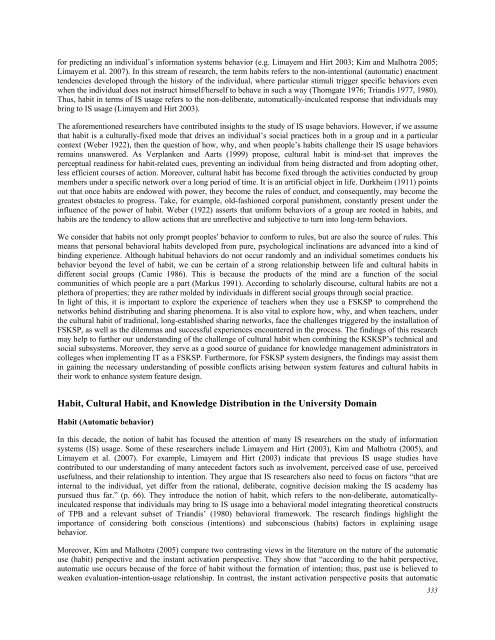October 2012 Volume 15 Number 4 - Educational Technology ...
October 2012 Volume 15 Number 4 - Educational Technology ...
October 2012 Volume 15 Number 4 - Educational Technology ...
You also want an ePaper? Increase the reach of your titles
YUMPU automatically turns print PDFs into web optimized ePapers that Google loves.
for predicting an individual’s information systems behavior (e.g. Limayem and Hirt 2003; Kim and Malhotra 2005;<br />
Limayem et al. 2007). In this stream of research, the term habits refers to the non-intentional (automatic) enactment<br />
tendencies developed through the history of the individual, where particular stimuli trigger specific behaviors even<br />
when the individual does not instruct himself/herself to behave in such a way (Thorngate 1976; Triandis 1977, 1980).<br />
Thus, habit in terms of IS usage refers to the non-deliberate, automatically-inculcated response that individuals may<br />
bring to IS usage (Limayem and Hirt 2003).<br />
The aforementioned researchers have contributed insights to the study of IS usage behaviors. However, if we assume<br />
that habit is a culturally-fixed mode that drives an individual’s social practices both in a group and in a particular<br />
context (Weber 1922), then the question of how, why, and when people’s habits challenge their IS usage behaviors<br />
remains unanswered. As Verplanken and Aarts (1999) propose, cultural habit is mind-set that improves the<br />
perceptual readiness for habit-related cues, preventing an individual from being distracted and from adopting other,<br />
less efficient courses of action. Moreover, cultural habit has become fixed through the activities conducted by group<br />
members under a specific network over a long period of time. It is an artificial object in life. Durkheim (1911) points<br />
out that once habits are endowed with power, they become the rules of conduct, and consequently, may become the<br />
greatest obstacles to progress. Take, for example, old-fashioned corporal punishment, constantly present under the<br />
influence of the power of habit. Weber (1922) asserts that uniform behaviors of a group are rooted in habits, and<br />
habits are the tendency to allow actions that are unreflective and subjective to turn into long-term behaviors.<br />
We consider that habits not only prompt peoples' behavior to conform to rules, but are also the source of rules. This<br />
means that personal behavioral habits developed from pure, psychological inclinations are advanced into a kind of<br />
binding experience. Although habitual behaviors do not occur randomly and an individual sometimes conducts his<br />
behavior beyond the level of habit, we can be certain of a strong relationship between life and cultural habits in<br />
different social groups (Camic 1986). This is because the products of the mind are a function of the social<br />
communities of which people are a part (Markus 1991). According to scholarly discourse, cultural habits are not a<br />
plethora of properties; they are rather molded by individuals in different social groups through social practice.<br />
In light of this, it is important to explore the experience of teachers when they use a FSKSP to comprehend the<br />
networks behind distributing and sharing phenomena. It is also vital to explore how, why, and when teachers, under<br />
the cultural habit of traditional, long-established sharing networks, face the challenges triggered by the installation of<br />
FSKSP, as well as the dilemmas and successful experiences encountered in the process. The findings of this research<br />
may help to further our understanding of the challenge of cultural habit when combining the KSKSP’s technical and<br />
social subsystems. Moreover, they serve as a good source of guidance for knowledge management administrators in<br />
colleges when implementing IT as a FSKSP. Furthermore, for FSKSP system designers, the findings may assist them<br />
in gaining the necessary understanding of possible conflicts arising between system features and cultural habits in<br />
their work to enhance system feature design.<br />
Habit, Cultural Habit, and Knowledge Distribution in the University Domain<br />
Habit (Automatic behavior)<br />
In this decade, the notion of habit has focused the attention of many IS researchers on the study of information<br />
systems (IS) usage. Some of these researchers include Limayem and Hirt (2003), Kim and Malhotra (2005), and<br />
Limayem et al. (2007). For example, Limayem and Hirt (2003) indicate that previous IS usage studies have<br />
contributed to our understanding of many antecedent factors such as involvement, perceived ease of use, perceived<br />
usefulness, and their relationship to intention. They argue that IS researchers also need to focus on factors “that are<br />
internal to the individual, yet differ from the rational, deliberate, cognitive decision making the IS academy has<br />
pursued thus far.” (p. 66). They introduce the notion of habit, which refers to the non-deliberate, automaticallyinculcated<br />
response that individuals may bring to IS usage into a behavioral model integrating theoretical constructs<br />
of TPB and a relevant subset of Triandis’ (1980) behavioral framework. The research findings highlight the<br />
importance of considering both conscious (intentions) and subconscious (habits) factors in explaining usage<br />
behavior.<br />
Moreover, Kim and Malhotra (2005) compare two contrasting views in the literature on the nature of the automatic<br />
use (habit) perspective and the instant activation perspective. They show that “according to the habit perspective,<br />
automatic use occurs because of the force of habit without the formation of intention; thus, past use is believed to<br />
weaken evaluation-intention-usage relationship. In contrast, the instant activation perspective posits that automatic<br />
333

















